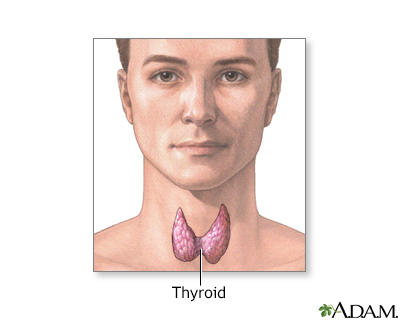Silent thyroiditis
Definition
Silent thyroiditis is an immune reaction of the thyroid gland. The disorder can cause hyperthyroidism, followed by hypothyroidism.
The thyroid gland is located in the neck, just above where your collarbones meet in the middle.
Alternative Names
Lymphocytic thyroiditis; Subacute lymphocytic thyroiditis; Painless thyroiditis; Postpartum thyroiditis; Thyroiditis - silent; Hyperthyroidism - silent thyroiditis
Causes
The cause of the disease is unknown. But it is related to an attack against the thyroid by the immune system. The disease affects women more often than men.
The disease can occur in women who have just had a baby. It can also be caused by medicines such as interferon and amiodarone, and some types of chemotherapy, which affect the immune system.
Symptoms
The earliest symptoms result from an overactive thyroid gland (hyperthyroidism). These symptoms may last for up to 3 months.
Symptoms are often mild, and may include:
- Fatigue, feeling weak
- Frequent bowel movements
- Heat intolerance
- Increased appetite
- Increased sweating
- Irregular menstrual periods
- Mood changes, such as irritability
- Muscle cramps
- Nervousness, restlessness
- Palpitations
- Weight loss
Later symptoms may be of an underactive thyroid (hypothyroidism), including:
- Fatigue
- Constipation
- Dry skin
- Weight gain
- Cold intolerance
These symptoms can persist until the thyroid recovers normal function. The recovery of the thyroid can take many months in some people. Some people only notice the hypothyroid symptoms and do not have symptoms of hyperthyroidism to begin with.
Exams and Tests
The health care provider will examine you and ask about your symptoms and medical history.
A physical examination may show:
- Enlarged thyroid gland that is not painful to the touch
- Rapid heart rate
- Shaking hands (tremor)
- Brisk reflexes
- Sweaty, warm skin
Tests that may be done include:
- Radioactive iodine uptake
- Thyroid hormones T3 and T4
- TSH
- Erythrocyte sedimentation rate
- C-reactive protein
Many providers now screen for thyroid disease before and after starting medicines that commonly cause this condition.
Treatment
Treatment is based on symptoms. Medicines called beta-blockers may be used to relieve rapid heart rate and excessive sweating.
Outlook (Prognosis)
Silent thyroiditis often goes away on its own within 1 year. The acute phase usually ends within 3 months.
Some people develop hypothyroidism over time. They need to be treated for a while with a medicine that replaces thyroid hormone. Regular follow-ups with a provider are recommended.
The disease is not infectious. People cannot catch the disease from you. It also is not inherited within families like some other thyroid conditions.
When to Contact a Medical Professional
Call your provider if you have symptoms of this condition.
Gallery

References
Hollenberg A, Wiersinga WM. Hyperthyroid disorders. In: Melmed S, Auchus RJ, Golfine AB, Koenig RJ, Rosen CJ, eds. Williams Textbook of Endocrinology. 14th ed. Philadelphia, PA: Elsevier; 2020:chap 12.
Jonklaas J, Cooper DS. Thyroid. In: Goldman L, Schafer AI, eds. Goldman-Cecil Medicine. 26th ed. Philadelphia, PA: Elsevier; 2020:chap 213.
Lakis ME, Wiseman D, Kebebew E. Management of thyroiditis. In: Cameron AM, Cameron JL, eds. Current Surgical Therapy. 13th ed. Philadelphia, PA: Elsevier; 2020:764-767.
